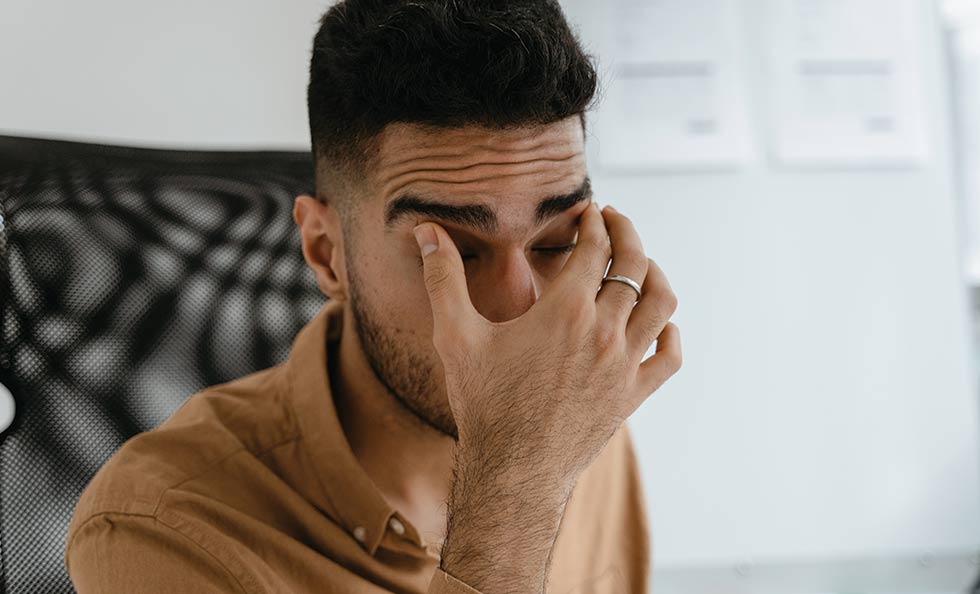Massage and special exercises for intracranial pressure are recognized as effective ways to treat ICD.
Sit on a chair and lean against its back before performing the massage. Take a comfortable, comfortable posture.
Head massage
Apply pressure with your fingertips. Painful sensations you may feel as you do this are a good indication that you have hit the right spot.
Place your left palm around the front of your neck, just below your lower jaw. Using the tip of your thumb, feel the pulsation of the carotid artery. Inhale and squeeze the artery for 5 to 10 seconds, then let it go as you exhale. Repeat three times. Switch hands: with your right hand, press on a symmetrical point.
2. Place your palms on the top of the back of the head. Run them, slowly and with some effort, sliding them down. Stroke the neck and clavicle area. Keep repeating this action for 1-2 minutes.
3. Place the fingertips of both hands on the lower edge of the occipital area and make circular movements, pressing on the base points of the skull. Vigorously massage the entire area from one ear to the other, periodically stroking the back of the neck from top to bottom. Perform the exercise for 2-3 minutes.
4. Place your palms on the back of the head and with the pads of your thumbs press firmly on all the points at the base of the skull (the pain may be severe – this is normal). Apply pressure to each pair of points for 1-2 minutes.
At the end of the self-massage session repeat the second technique.
AMONG THE CAUSES OF INTRACRANIAL PRESSURE MAY BE:
- head trauma,
- inflammation of the membranes of the brain,
- rupture of a section of the cerebral artery,
- constricted vessels,
- tumors,
- congenital hydrocephalus (hydrocephalus of the brain),
large amounts of cerebrospinal fluid, impaired cerebrospinal fluid circulation or absorption.
SYMPTOMS OF ELEVATED INTRACRANIAL PRESSURE IN ADULTS:
In addition to the elevated values (more than 100-180 mm Hg) that characterize intracranial pressure, the symptoms of this ailment are as follows:
- Frequent and constant headaches, increasing in the evening and at night;
nausea (without vomiting); - increased irritability, lethargy, affecting mental activity, fatigue;
vegetovascular dystonia; - Dilation of the pupil and lack of reaction to light, “flies” in the eyes;
- Paresis (loss of muscle strength) of the muscles on one side of the body, similar in appearance to paralysis;
- bouts of sweating;
- pre-consciousness;
- “under-eyes” (dark circles and bags under the eyes).
PREVENTION OF INCREASED INTRACRANIAL PRESSURE:
- You should limit or completely eliminate the intake of salt, to sit on a special diet prescribed by the doctor;
- Strictly dosed consumption of fluids;
- The doctor may prescribe special exercises to improve the pressure;
- Complete renunciation of baths or saunas;
- To sleep, it is necessary to choose high pillows;
- Swimming in a pool to reduce intracranial pressure is recommended;
- Acupuncture and physical therapy may be prescribed;
- Visiting a masseur – special attention should be paid to massage of the collar zone;
- Consumption of products containing potassium (green vegetables, potatoes, apricots, and many citrus fruits) considerably improves well-being;
- It is categorically not recommended to make air flights, drastically change the climate and atmosphere of residence, and time zones;
- Physical activity should be moderate to reduce and normalize intracranial pressure
*These articles are for informational and educational purposes only and are not intended as a substitute for professional medical advice, diagnosis or treatment. Always consult your physician for any questions you may have about your medical condition.




